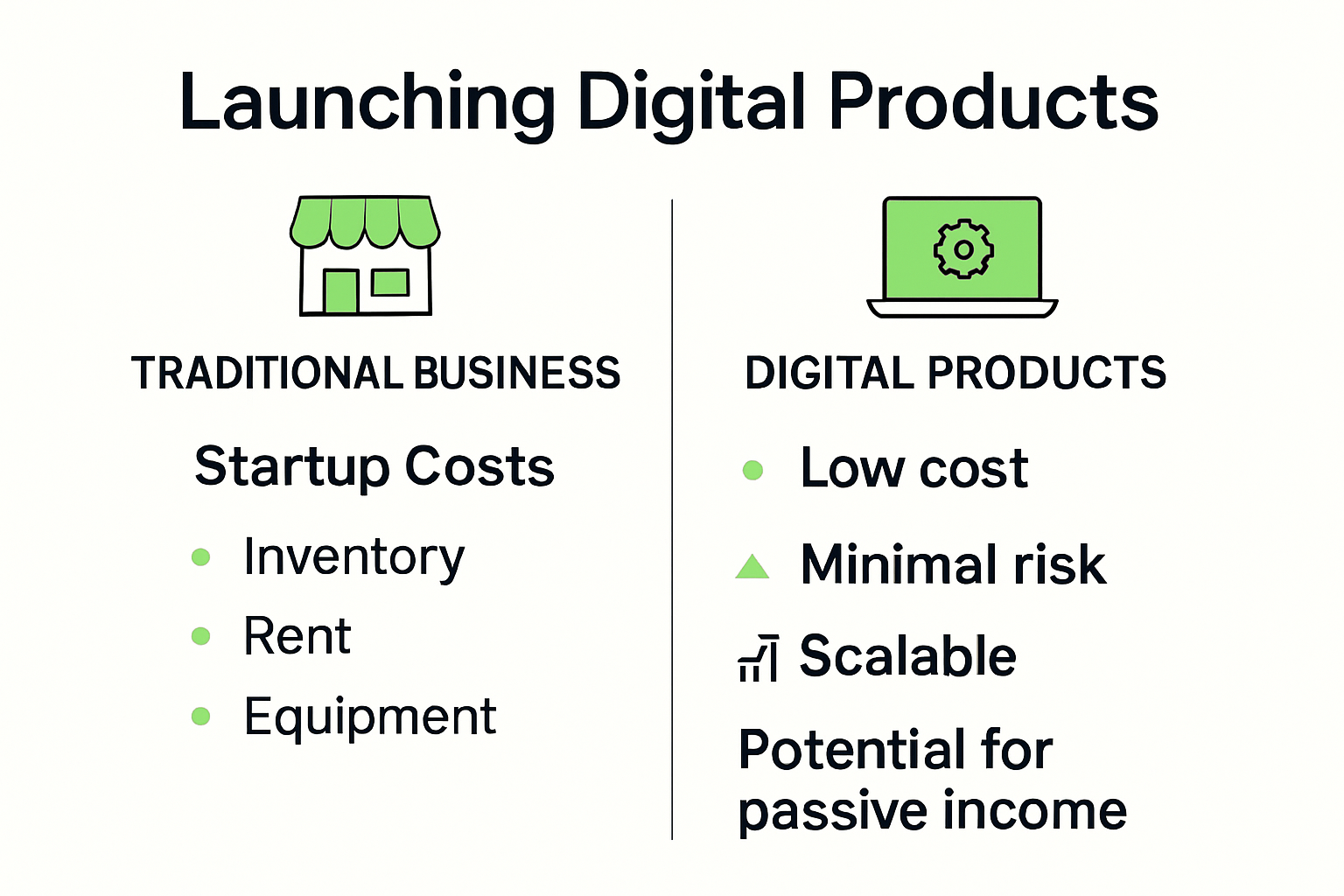
Top Digital Product Ideas for Beginners in 2025
Launching a digital product is now within reach for almost anyone and the barriers have never been lower. Starting up online can cost as little as a laptop and Wi-Fi—no inventory, no warehouses, just your skills. But hold up. The real surprise is not just about low upfront investment anymore. The true edge in 2025 is about tapping into hyper-specialized trends and AI tools that most beginners overlook. Ignore the old blanket approaches and you may discover untapped income streams the big players have missed.
Table of Contents
- Why Digital Products Are Perfect For Beginners
- The Low-Risk Investment Pathway
- Flexibility And Scalability
- Global Reach And Passive Income Potential
- Best Digital Product Ideas For 2025
- AI-Powered Digital Solutions
- Hyper-Specialized Digital Experiences
- Immersive And Sustainable Digital Offerings
- How To Choose The Right Idea For You
- Assessing Your Personal Skills And Expertise
- Evaluating Market Demand And Viability
- Prototyping And Validation
- Getting Started: Simple Steps To Launch
- Define Your Product And Value Proposition
- Build And Test Your Minimum Viable Product
- Marketing And Launch Strategy
Quick Summary
Why Digital Products Are Perfect for Beginners
Starting a business can feel overwhelming, especially for newcomers. Digital products offer an incredible entry point for aspiring entrepreneurs, providing low barriers to entry, minimal upfront costs, and remarkable scalability. Understanding why digital products are ideal for beginners requires examining their unique advantages and potential for success.
The Low-Risk Investment Pathway
Digital products represent an extraordinary opportunity for entrepreneurs with limited resources. Unlike traditional business models requiring substantial capital investments, digital products can be created with minimal financial risk. Research from Illinois Education highlights how digital platforms provide flexible learning and creation environments that empower individuals to develop and monetize their skills.
The startup costs for digital products are dramatically lower compared to physical goods. You do not need inventory, warehousing, or complex supply chain management. A laptop, internet connection, and your unique expertise become your primary business assets. Whether you’re developing an online course, writing an ebook, creating digital templates, or designing software tools, the initial investment remains remarkably small.
Flexibility and Scalability

Mobile learning research demonstrates how digital platforms enable unprecedented flexibility in content creation and distribution. Digital products can be developed around your existing schedule, allowing you to build your business without quitting your day job. This gradual approach reduces financial pressure and allows for organic growth.
Scalability is another significant advantage. Unlike physical products constrained by manufacturing and shipping limitations, digital products can be replicated infinitely at zero additional cost. Once you create a digital course or software tool, you can sell it repeatedly without incremental production expenses. This means your potential earnings are not limited by traditional manufacturing constraints.
Global Reach and Passive Income Potential
Digital products break geographical boundaries, allowing entrepreneurs to reach global audiences instantly. Educational technology studies reveal how digital platforms can serve as powerful substitutes for traditional resources, providing critical support to learners worldwide.
The passive income model inherent in digital products is particularly attractive for beginners. After initial product development, you can generate revenue while sleeping, traveling, or working on other projects. This passive income stream provides financial flexibility and reduces the intense time commitment required by traditional business models.
Successful digital product creation requires understanding your target audience, delivering genuine value, and continuously refining your offering. While the barriers to entry are low, success demands creativity, market research, and consistent effort. Digital products are not a get-rich-quick scheme but a strategic pathway for entrepreneurs willing to invest time in developing high-quality, solution-oriented offerings.
For beginners seeking a flexible, low-risk business model with significant growth potential, digital products represent an ideal starting point. Your unique skills, knowledge, and creativity become your most valuable business assets.
To provide a clearer overview, here’s a table summarizing the key advantages of digital products for beginners:
Best Digital Product Ideas for 2025
The digital product landscape is rapidly evolving, offering exciting opportunities for aspiring entrepreneurs. As we approach 2025, emerging technologies and changing consumer behaviors are creating unique niches for innovative digital products. Learn more about finding business ideas that can transform your entrepreneurial journey.
AI-Powered Digital Solutions
Research from Financial Times reveals how artificial intelligence is revolutionizing product development across multiple sectors. AI-driven digital products are becoming increasingly sophisticated, offering personalized experiences that were unimaginable just a few years ago. TechRadar’s comprehensive review highlights the incredible diversity of AI tools available, from advanced chatbots to intelligent content creation platforms.
Consider developing digital products that leverage AI capabilities. This could include specialized AI-powered learning tools, personalized coaching platforms, intelligent template generators, or niche problem-solving applications. The key is to identify specific pain points where AI can provide unique, tailored solutions that traditional methods cannot.
Hyper-Specialized Digital Experiences
Market trend research indicates a growing demand for hyper-niche digital products that cater to very specific audience needs. The era of one-size-fits-all solutions is fading, replaced by highly targeted digital experiences that speak directly to unique user requirements.
Successful digital products in 2025 will likely focus on micro-communities and specialized interests. This could mean creating digital templates for specific professional niches, developing targeted online courses for emerging skill sets, or designing interactive digital resources that serve very specific audience segments. The more precisely you can define and solve a particular problem, the more valuable your digital product becomes.
Immersive and Sustainable Digital Offerings
Consumers are increasingly seeking digital products that offer more than just functional utility. They want immersive experiences that engage multiple senses and align with broader social values. Augmented reality (AR) and virtual reality (VR) digital products present extraordinary opportunities for innovative entrepreneurs.
Sustainability is another crucial consideration. Digital products that demonstrate environmental consciousness or support sustainable practices will likely gain significant traction. This might include digital tools that help users track and reduce their carbon footprint, platforms that facilitate eco-friendly community actions, or educational resources about sustainable living.
The digital product landscape in 2025 demands creativity, technological understanding, and a deep connection to user needs. Successful creators will be those who can combine cutting-edge technology with genuine problem-solving capabilities. Whether you’re developing an AI-powered solution, a hyper-specialized digital experience, or an immersive sustainable platform, the key is to focus on delivering exceptional value.
Remember, the best digital products are not just about technology. They’re about understanding human needs, solving real problems, and creating meaningful connections in an increasingly digital world.
To help you compare the major types of digital product opportunities for 2025, here’s a table outlining their core focus and potential examples:
How to Choose the Right Idea for You
Selecting the perfect digital product idea requires more than just creativity it demands strategic thinking and self-awareness. Discover your entrepreneurial niche by understanding your unique strengths and market opportunities.
Assessing Your Personal Skills and Expertise
Research from Thinkific emphasizes the critical importance of aligning your digital product with your existing skills and knowledge. Your personal expertise is not just an asset it is the foundation of a potentially successful digital product.
Start by conducting a comprehensive skills audit. List your professional experiences, academic background, hobbies, and unique knowledge areas. Look for intersections between your skills and potential market needs. For instance, if you have experience in project management and understand common workplace challenges, you might develop a digital template or productivity tool that solves specific workflow problems.
Systematic research on machine-driven analytics suggests using advanced techniques like text mining and AI to identify potential innovation opportunities. These technologies can help you map your skills against emerging market trends, revealing hidden product possibilities you might not have considered.
Evaluating Market Demand and Viability
Understanding market demand is crucial for digital product success. Future Vista Academy’s analysis highlights the importance of matching personal expertise with genuine market needs.
Conduct thorough market research to validate your digital product idea. Use tools like Google Trends, social media listening platforms, and industry forums to gauge potential interest. Look for specific pain points within your target audience that your digital product could solve. Pay attention to frequently asked questions, common complaints, and emerging challenges in online communities related to your potential product.
Consider the scalability and long-term potential of your idea. A great digital product should not only solve an immediate problem but also have the potential to evolve and adapt to changing market dynamics. Ask yourself: Can this product provide ongoing value? Is there room for future iterations or expansions?
Prototyping and Validation
Before fully committing to your digital product, create a minimal viable prototype or proof of concept. This approach allows you to test your idea with a small audience and gather critical feedback. Leverage online platforms, social media groups, and professional networks to find potential beta testers who can provide honest, constructive insights.
During the validation phase, be open to pivoting or refining your original concept. The most successful digital products often emerge from iterative development and continuous user feedback. Your initial idea might be good, but the version shaped by real-world testing could be exceptional.
Remember that choosing the right digital product idea is a process of exploration, self-discovery, and market understanding. It requires patience, research, and a willingness to adapt. Your unique combination of skills, market insights, and creative problem-solving will ultimately guide you toward a digital product that is not just viable but potentially transformative.
The perfect digital product idea exists at the intersection of your expertise, market demand, and innovative thinking. Trust your skills, remain curious, and be prepared to learn and evolve throughout your entrepreneurial journey.
Getting Started: Simple Steps to Launch
Launching your first digital product can feel intimidating, but with a structured approach, you can transform your idea into a successful business. Learn how to analyze your first business opportunity and set yourself up for success from the start.
Define Your Product and Value Proposition
Forbes research highlights the critical importance of identifying a specific problem your digital product will solve. This means going beyond a generic solution and creating something that addresses a genuine market need.
Start by clearly articulating your product’s unique value proposition. What specific problem does your digital product solve? Who exactly will benefit from it? The more precisely you can define your target audience and their pain points, the more effectively you can design and market your product.
University of Arts London’s guide recommends conducting in-depth user research. Interview potential customers, participate in online forums, and analyze existing solutions in your chosen niche. This research will help you refine your product concept and ensure you’re creating something people actually want.
Build and Test Your Minimum Viable Product
Developing an MVP allows you to test your concept with minimal investment. Focus on creating a simple, functional version that solves the primary problem for your target audience. This approach enables you to gather critical user feedback, validate your product idea, and make necessary improvements before a full-scale launch.
Consider using no-code or low-code platforms that allow rapid prototyping. These tools can help you quickly create a functional version of your digital product without extensive technical expertise. Platforms like Webflow, Bubble, or Glide can be incredibly useful for beginners looking to bring their digital product to life.
To help visualize your path, here is a step-by-step table summarizing the key stages to launch your digital product:
Marketing and Launch Strategy

A successful launch requires more than just a great product. You need a strategic approach to reach and engage your target audience. Start by building an online presence that showcases your expertise and product value. This might include creating content on platforms like LinkedIn, YouTube, or industry-specific forums where your potential customers gather.
Develop a pre-launch marketing strategy that builds anticipation. This could involve creating a landing page, offering early-bird discounts, or providing exclusive access to beta testers. Use social media and email marketing to create buzz around your digital product.
Pricing is another crucial consideration. Research similar products in your niche and position your offering competitively. Consider offering introductory pricing or tiered options that make it easy for customers to try your product.
Remember that launching a digital product is an iterative process. Be prepared to listen to user feedback, continuously improve your offering, and adapt to market needs. Your first version doesn’t need to be perfect it needs to be valuable and solve a real problem.
The journey of creating and launching a digital product is as much about learning and growing as it is about the product itself. Stay curious, remain open to feedback, and be willing to pivot when necessary. Your first digital product is just the beginning of your entrepreneurial adventure.
Frequently Asked Questions
What are the benefits of selling digital products for beginners?
Selling digital products for beginners offers low upfront costs, high scalability, global reach, and the potential for passive income. They require minimal financial investment compared to traditional businesses, allowing newcomers to enter the market with less risk.
What types of digital products are popular in 2025?
In 2025, popular digital products include AI-powered solutions, hyper-specialized digital experiences, and immersive offerings using technologies like augmented reality (AR) and virtual reality (VR). These products cater to specific niche markets and user needs.
How do I choose the right digital product idea?
To choose the right digital product idea, assess your personal skills and expertise, evaluate market demand, and prototype potential concepts. Align your product idea with your unique strengths and the emerging needs of the market for optimal success.
What is a Minimum Viable Product (MVP) and why is it important?
A Minimum Viable Product (MVP) is a simplified version of your digital product that allows you to test core features with real users. It’s important because it helps you validate your concept, gather user feedback, and make necessary improvements before a full launch.
Turn Your Digital Product Idea Into a Real Business with Smart Guidance
Feeling overwhelmed by all the advice on launching digital products? The article highlighted how beginners face uncertainty about market demand, picking the right niche, and building something people actually want. Many creators struggle to bridge the gap from a great idea to a successful launch, especially when it comes to testing and refining their first Minimum Viable Product. If you want to avoid wasted time and costly mistakes, the best step is to work smarter with personalized support.
Let siift become your AI-powered business partner. You can get step-by-step guidance tailored to your strengths, quickly map your skills to real market needs, and gain feedback to perfect your product idea. You do not have to guess what comes next – siift’s platform shows you proven actions, helps validate your concept, and saves you months of trial and error. Take the next step now by starting your founder journey with siift and turn your vision for 2025 into real, scalable success.
Recommended
- blog | siift | our outlook on founders, business & Ai
- blog | siift | How to Find Business Ideas in 2025: Proven Steps for Students and New Grads
- blog | siift | Creative Thinking Exercises for Future Entrepreneurs 2025
- blog | siift | How to Validate Idea in 2025: A Simple Guide for New Founders
- Content Personalization Ideas for CRO Marketers in 2025
- Top Digital Marketing Channels for Success in 2025

see where you stand





.svg)
.svg.png)



.svg)

